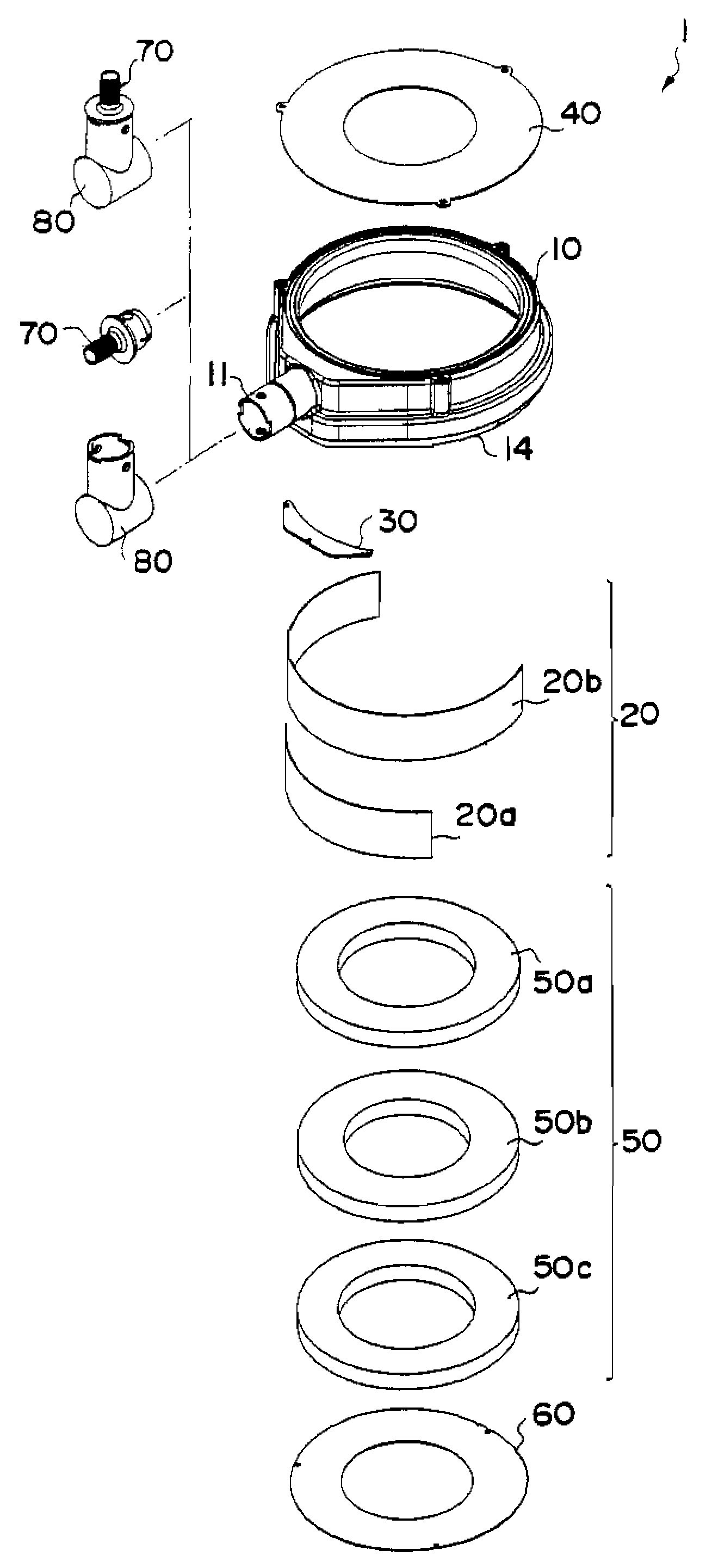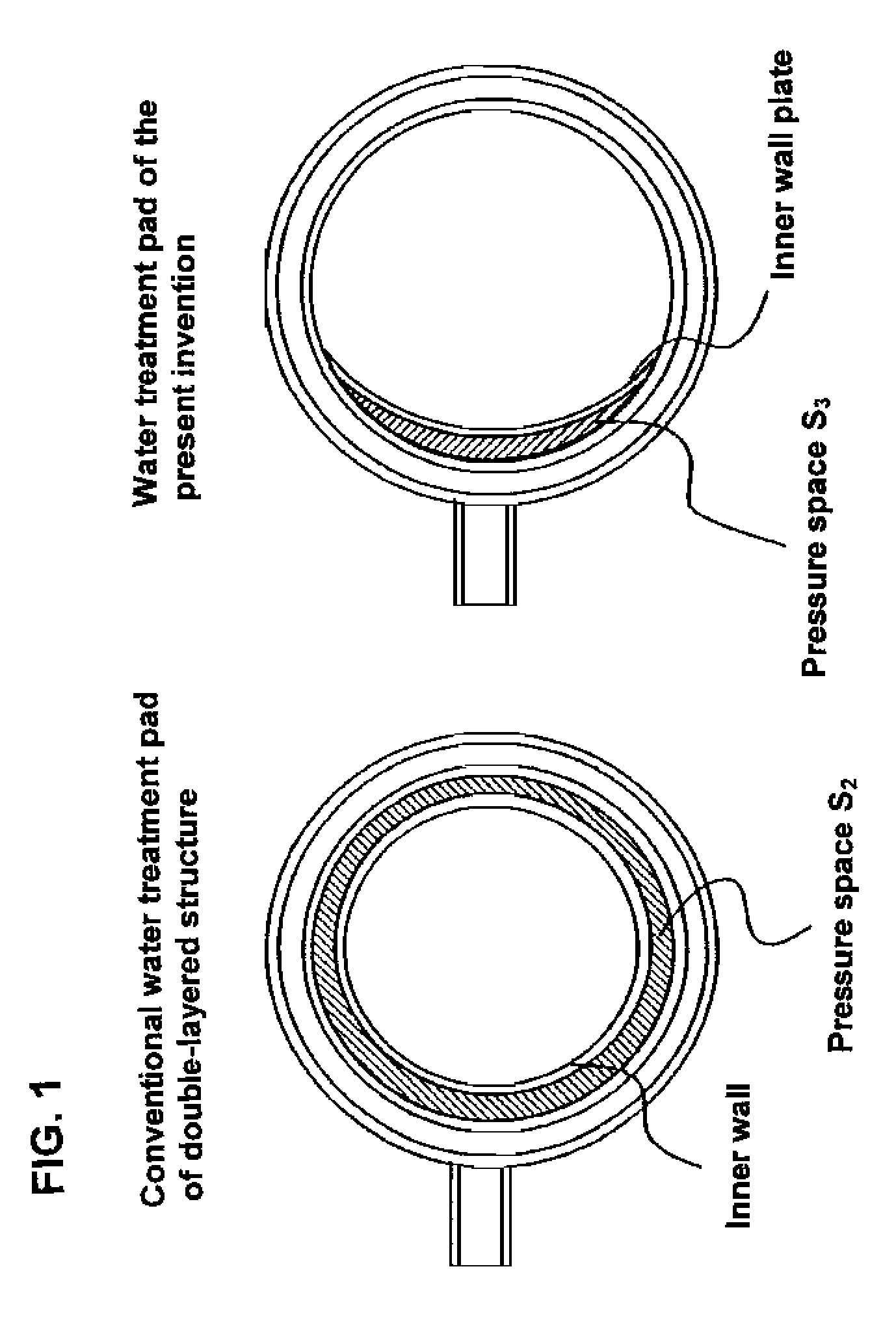Water treatment pad for core drill
a technology for treating pads and core drills, applied in the direction of manufacturing tools, borehole/well accessories, transportation and packaging, etc., can solve the problems of difficult removal, easy clogging of the water treatment pad, and not always providing a significant effect, so as to reduce the pressure space, and improve the effect of drainag
- Summary
- Abstract
- Description
- Claims
- Application Information
AI Technical Summary
Benefits of technology
Problems solved by technology
Method used
Image
Examples
first embodiment (
Drilling Floor Surface)
[0047]To drill a floor surface with the water treatment pad 1 according to the present embodiment, the water treatment pad 1 is composed of the pad main body 10 and the inner wall plate 20a. The shielding plate 30 may be included in the water treatment pad 1. In drilling work, as shown in FIG. 5, the water treatment pad is attached onto a floor surface and a vacuum cleaner (not shown) is connected to the drain outlet 11. In installation, the pad 1 is fixed from the above, by which the sponge rubber 14 at the lower end of the pad main body 10 contracts to keep a static suction head by the cleaner low. After attachment and fixing of the water treatment pad 1, a core drill C is located at a drilling position from a top opening and a drive motor (not shown) is actuated to start drilling. During drilling work, cutting water is supplied from the inside of the core drill C and the cutting water rises to a position of a cutting water line L, however, is sucked by the ...
second embodiment (
Drilling Wall Surface)
[0050]To drill a wall surface with the water treatment pad 1 according to the present embodiment, the water treatment pad 1 is composed of the pad main body 10, the inner wall plate 20b and the shielding plate 30. FIG. 7 shows a perspective rear view of a state where these members are combined. The shielding plate 30 in the present embodiment is a roughly trapezoidal plate member adapted to a shape of around the drain outlet 11. Attaching the shielding plate 30 permits a space formed by a bump portion near the drain outlet 11 to be thrust out of the pressure space, thus reducing the volume (cross section) of the pressure space.
[0051]The inner wall plate 20b used in drilling a wall surface is longer than the inner wall plate 20a. This is because the position of the pressure space should be adjusted in accordance with the attachment state of the pad 1. In other words, as described below, drilling a wall surface needs adjusting orientation of the drain outlet in c...
third embodiment (
Drilling Ceiling Surface)
[0055]The water treatment pad according to the present embodiment is applicable to drilling a ceiling surface. In this case, the water treatment pad 1 is constituted of the pad main body 10 and the lower circular plate 60. In drilling a ceiling surface, the inner wall plates 20a, 20b and the shielding plate 30 do not have to be used, but may be provided.
[0056]FIG. 9 is a sectional view of the water treatment pad 1. The lower circular plate 60 has a hole for inserting a core drill in the center thereof, and the diameter of the hole is a little larger than the outside diameter of the core drill. Specifically, it is preferable to define a diameter of 1.01-1.2 times as large as the outside diameter of a core drill used. Too small hole diameter may impair rotation of the core drill, while too large hole diameter may fail in suction of the cleaner, thus leaking cutting water. The guides 12a-12f are formed with a protrusion portion 16 the top of which is flat so as...
PUM
| Property | Measurement | Unit |
|---|---|---|
| angle | aaaaa | aaaaa |
| angle | aaaaa | aaaaa |
| angle | aaaaa | aaaaa |
Abstract
Description
Claims
Application Information
 Login to View More
Login to View More - R&D
- Intellectual Property
- Life Sciences
- Materials
- Tech Scout
- Unparalleled Data Quality
- Higher Quality Content
- 60% Fewer Hallucinations
Browse by: Latest US Patents, China's latest patents, Technical Efficacy Thesaurus, Application Domain, Technology Topic, Popular Technical Reports.
© 2025 PatSnap. All rights reserved.Legal|Privacy policy|Modern Slavery Act Transparency Statement|Sitemap|About US| Contact US: help@patsnap.com



